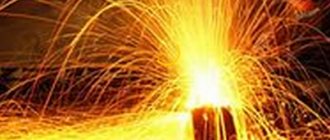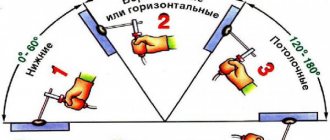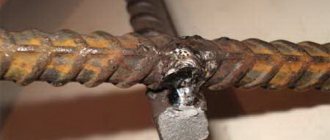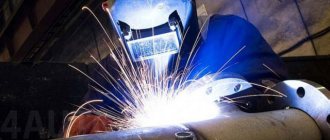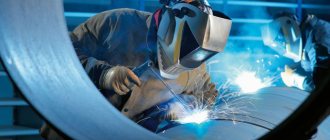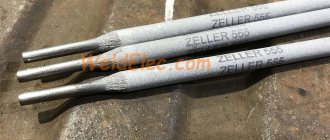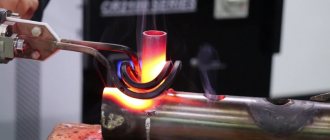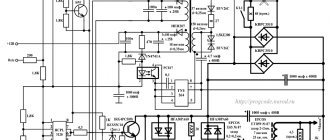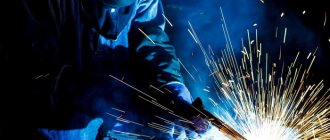Currently, welding of dissimilar steels is often encountered in various industries. This action is most often necessary in cases where there is a need to create connections from steels that differ in their properties: for example, to connect in one product a part made of high-alloy steel, which will be exposed to aggressive influences during operation, and a part made of low-alloy steel, which the load during operation will be significantly less.
Welding of dissimilar steels
In modern conditions, special mechanical engineering is developing in many directions.
However, the main thing is to reduce the metal spent on the manufacture of equipment with a parallel increase in the power of this equipment. This purpose requires the active use of alloy steels and alloys. Not all products are made from materials of this kind that are exposed to high temperatures and pressure, as well as corrosive environments. advisable to use welding to connect parts made of dissimilar steels in one structure . A welded connection has a positive effect on several points:
- the most rational use of materials in the product;
- a significant reduction in the cost of this product due to the use of alloy steels;
- improving the manufacturability of the design.
Such welded parts are successfully used in several branches of mechanical engineering: energy, chemical and oil.
Where and why are dissimilar steels and alloys used?
In modern industry, structures made from such materials are widely used. They are necessary where their individual parts operate under different conditions - under different alternating loads, temperature levels and aggressiveness of environments, abrasive wear, pressure, etc. In a number of such areas:
- rocket science;
- shipbuilding;
- energy (nuclear, thermal);
- radio electronics;
- mechanical engineering;
- cryogenic plants, etc.
Constructions of this type are called combined. They provide the necessary technical and technological characteristics of the equipment, and in a wide range of cases allow making its production more economical.
Specifics of welding dissimilar steels
Welded joints of dissimilar steels have their own specific characteristics. When working with these materials, the main problem is preventing the formation of structural heterogeneity , which can lead to premature destruction of the entire structure.
To prevent heterogeneity, austenitic metal welded to non-austenitic metal must be saturated with nickel. However, nickel has several disadvantages: high cost and scarcity of this metal. In addition, nickel promotes the appearance of hot cracks. Therefore, when joining steels operating at high temperatures, it is necessary to simultaneously increase and decrease the amount of nickel .
On the one hand, given the opportunity to prevent heterogeneity, and on the other hand, one should remember the negative impact of nickel on the connection. These findings mean that for a weld metal of this type there should be an “ideal” nickel content . It is determined by the factors that have the greatest influence on the formation of heterogeneity in the working area.
How to weld dissimilar materials?
You should know that if you work with ferritic and austenitic-ferritic, pearlitic and martensitic, as well as high-chromium steel, you should be careful, since in such a process problems such as cold cracks and interlayers often arise.
To improve the quality of the seam, you need to use pearlite electrodes, which are used in manual welding. Submerged arc wire is also suitable as an alternative. Only in this case will the seam be plastic and durable, since it will contain a minimum of chromium. The operating temperature is the same as in high-alloy steels.
Typically, heat treatment is not used when working with such alloys and metals. But this has a detrimental effect on durability, so it is better to still process it, but at a minimum level that will prevent the formation of layers.
In fact, working with different metals is quite complicated, so if you need to weld an important part, it is better to practice on unnecessary parts, and only then start the main work.
Classification of welded joints of dissimilar steels
Thus, welded joints of materials of dissimilar types were divided into 4 groups. The distinction is made depending on the temperature of their operation. Each category has its own optimal value, which is acceptable for the non-austenitic steel used in it:
- 1st group – up to 350°C;
- 2nd – 350-450°C;
- 3rd – 450-550°C;
- 4th – more than 550°C.
Electrodes TsL 9 in a package.
Research has shown that the deposited metal of group 1 compounds must have at least 8% nickel, group 2 – 19%, group 3 – 31%, group 4 – 47%. Accordingly, to create connections that are operated at temperatures up to 350°C, the following brands of electrodes can be used: GS-1, OZL-6, OZL-27 and TsL-9.
Welding consumables OZL-6 provide deposited metal of type E-10Х25НВГ2. TsL-9 electrodes are additionally alloyed with niobium and have a deposited metal type of 10Х25Н13Г2Б. OZL-27 electrodes are additionally supplied with molybdenum and guarantee a deposited metal of the following chemical composition: carbon - 0.18%, silicon - 0.6%, manganese - 1.63%, nickel - 10.3%, chromium - 25.3% , molybdenum – 3.1%. GS-1 materials provide the chemical composition of the following proportions: carbon - 0.09%, silicon - 2.5%, manganese - 6.3%, nickel - 9.4%, chromium - 23.3%.
Weldability of copper to steel
Certain difficulties in the process of joining these metals arise due to the difference in the level of their thermal conductivity, as well as due to the low melting point of copper. That is why, before starting the process, you should take into account all the features of the materials and choose the most optimal welding method. Only in this case can you obtain a high-quality connection that will have all the necessary characteristics.
Application of shielding gases
In fact, copper and all its alloys weld quite well with steel. Perhaps the highest quality is the connection made by argon arc welding. With its help, a seam is formed, which is characterized by good tightness and strength. Argon arc welding is performed using tungsten electrodes or a plasma jet and a special filler wire. Please note that during operation the arc should be slightly shifted towards the copper, which will help prevent overheating of the steel.
Welding of copper and steel can also be done using fluxes under shielding gases. In this case, consumable or non-consumable electrodes and wire are used. When fusing copper onto steel, the arc method of welding ceramic fluxes is quite effective, which allows you to achieve the required wear resistance and hardness of the material. This type of work involves the use of flat electrodes.
Steel hardening technology involves heating steel to a temperature above the critical temperature, followed by rapid cooling. A metal brazier is an activity that every welder can do. How to make it yourself, read this article.
How to weld high-strength steel correctly? Find out about this at https://elsvarkin.ru/texnologiya/vysokoprochnye-stali-i-osobennosti-ix-svarki/ link.
Development of electrodes for dissimilar steels
For the manufacture of joints operating at temperatures above 350°C, specialists from the Institute of Electric Welding named after. E.O.Paton has developed a line of special electrodes: ANZHR-3 are designed for temperatures of 350-450°C, ANZHR-2 – 450-550°C and ANZHR-1 – above 550°C. These welding consumables guarantee optimal nickel content in the weld and prevent the appearance of heterogeneity. In addition, they have high mechanical characteristics and a stable chemical composition. Also, when welding with these electrodes, there is no need to preheat the products being welded and then subject them to heat treatment.
Dissimilar steels and alloys are considered materials that differ sharply in physical and mechanical properties, chemical composition and weldability. Based on heterogeneity, steel can be divided into 4 groups:
- carbon and alloyed,
- alloyed with increased and high strength,
- heat resistant,
- highly alloyed.
Why are not all electrodes suitable for welding dissimilar steels?
When dissimilar metals (alloys) are welded, the fusion of dissimilar structures can reveal certain defects in welded joints:
- cracks in the metal of the weld itself;
- the appearance of areas with structural heterogeneity in melting zones;
- due to significantly different expansion coefficients of the metals being welded, an increase in excessive residual stresses.
Most electrodes used in welding dissimilar steels and alloys are electrodes designed for welding high-alloy steels and high-strength alloy steels, which produce a weld with a uniform, highly plastic metal structure.
Video
Watch a video about the Zeller 655 brand of electrodes; this company’s development is impressive in its capabilities.
Weldability of cast iron and steel
Despite the fact that cast iron and steel have similar chemical compositions, the process of welding these metals is also characterized by certain difficulties. The fact is that cast iron contains a large amount of carbon, and therefore is quite difficult to melt. To weld these dissimilar materials, special electrodes are used. To obtain a reliable and durable seam, parts should be thoroughly cleaned before processing, especially for workpieces made of cast iron, which easily absorbs various technical liquids.
Heating the product during operation
To join cast iron and steel, a welding current of reverse polarity is usually used. However, please note that in case of using devices with high no-load current, it is necessary to use alternating current. During operation, the parts must be heated to 600 degrees Celsius. This temperature will avoid excessive expansion of the metal, which often leads to irreversible deformation of the material. As a result of welding work carried out using the described technology, a strong, sealed seam is formed in just one pass.
If heating the workpieces is not possible, welding cast iron with steel is performed slightly differently. When it is necessary to join parts that are too large or the metal has fusible inclusions, the welding process is carried out using short rollers, each of which must be cooled before using the next. It is worth noting that this welding method does not provide the proper strength of the seam, therefore, for joining cast iron and steel, a method that involves preheating the parts is more preferable.
Methods of welding products made of stainless steels and dark alloys
In order to weld workpieces made of stainless steel and dark iron alloys, while obtaining high-quality and reliable connections, the following types of welding are used:
- in MMA mode;
If welding of products made of a dark alloy and stainless steel is carried out using the first technology (MMA), then you need to take electrodes specially designed for making connections of non-ferrous metals and alloys.
Brands and application of high-alloy electrodes
But it is best to cook stainless steel and dark alloys in an argon protective gas environment. For this, naturally, you will need a special welding machine. In this case, argon provides reliable protection of the zone of the weld being created from excessive saturation of the alloy with nitrogen and its oxidation. If such protection is not provided, the alloy of the formed weld will be very brittle, which will significantly reduce the reliability of the acquired joint.
Argon welding scheme for stainless steel
In order to perfectly weld products made from stainless steel and dark alloys, during the operation you need to monitor the position of the electrode. In order for the weld to be of high quality and reliability, the end seam must be kept perpendicular to the surface of the workpieces being joined.
Welding aluminum with titanium
In this case, difficulties arise with the emergence of an intermetallic zone, leading to brittleness of the joint.
Type of welding – argon-arc, non-consumable electrode
Additive material – aluminum wire AB00
Welding process technology - carefully cleaned edges with cut chamfers are aluminized (alluminized when heated at 800 - 830˚C). Welding is carried out using the usual method for aluminum alloys, shifting the arc towards a more refractory material.

